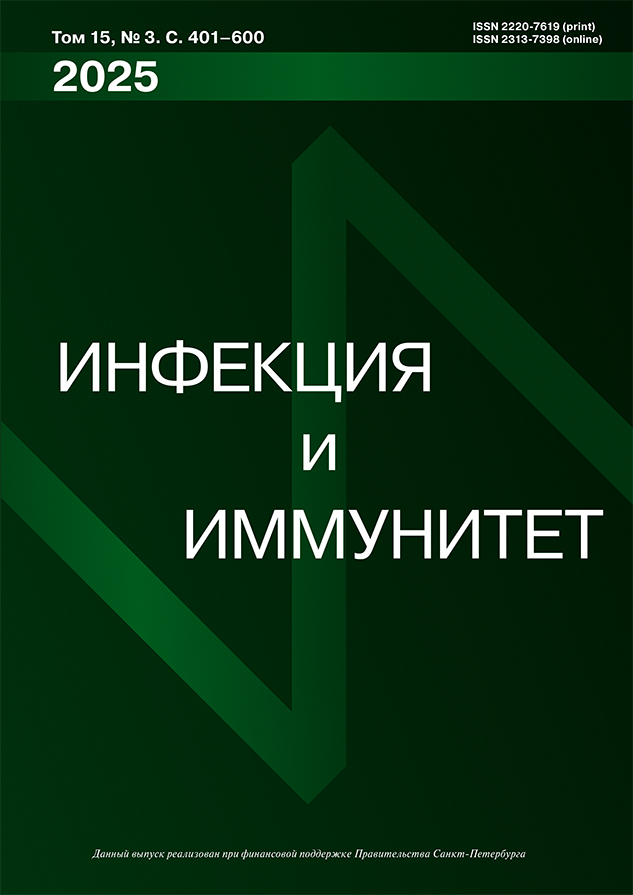Редкий случай инфекции мочевых путей, вызванной StenotrophomonaS maltophilia
- Авторы: Сейтопулу К.1, Стамули М.2, Каллиора Д.3, Мурцику А.4
-
Учреждения:
- Центр первичной помощи
- Госпиталь военно-морских сил и ветеранов Афин
- Афинский национальный университет имени Каподистрии
- «Агиос Пантелеймон»
- Выпуск: Том 14, № 2 (2024)
- Страницы: 392-396
- Раздел: КРАТКИЕ СООБЩЕНИЯ
- Дата подачи: 24.05.2023
- Дата принятия к публикации: 16.02.2024
- Дата публикации: 05.08.2024
- URL: https://iimmun.ru/iimm/article/view/12109
- DOI: https://doi.org/10.15789/2220-7619-CPO-12109
- ID: 12109
Цитировать
Полный текст
Аннотация
Stenotropomonas maltophilia является новой аэробной, неферментирующей, грамотрицательной, полирезистентной глобальной условно-патогенной палочкой. S. maltophilia вызывает широкий круг инфекций, включая инфекции дыхательных путей, инфекции кровяного русла и, реже, инфекции желчевыводящих путей, инфекции кожи и мягких тканей, а также инфекции костей и суставов. Все чаще сообщается, что она вызывает инфекции мочевыводящих путей (ИМП). В настоящей работе описывается 87-летний пациент мужского пола, посетивший лабораторию биопатологии Центра первичной медико-санитарной помощи Никея, Пирей, Греция, для планового осмотра по направлению семейного врача (GP). В анамнезе больного выявлен сахарный диабет 2 типа, артериальная гипертензия, гиперхолестеринемия, гипертриглицеридемия, гиперурикемия, хроническая обструктивная болезнь легких, рак предстательной железы по Глисону 6 баллов, диагностированный в возрасте менее 30 лет, оперированный менее 15 лет назад, с последующим проведением гормональной и лучевой терапии. В анамнезе пациента также были выявлены камни мочевыводящих путей и 3 эпизода обструктивного пиелонефрита за последние 5 лет с последующей госпитализацией и назначением внутривенного лечения антибиотиками. Во время госпитализации ему был установлен постоянный катетер мочевого пузыря, с назначением специального противомикробного лечения при выявлении различных микроорганизмов, обнаруженных в образцах мочи: Escherichia coli, Klebsiella pneumoniae, Proteus mirabilis и Enterococcus faecalis. Недержание мочи наблюдалось в течение 15 лет после операции по поводу рака простаты. Более того, в течение последних 5 лет пациент испытывал многочисленные трудности в повседневной жизни из-за недержания мочи, что удалось нивелировать путем катетеризации мочевого пузыря, что еще больше ухудшило состояние пациента рецидивами ИМП и новыми эпизодами пиелонефрита с последующей госпитализацией. Анализ мочи выявил протеинурию, выраженную пиурию, множественные микроорганизмы и эритроциты. В посеве мочи обнаружен мономикробный штамм Stenotropomonas maltophilia > 105 КОЕ/мл, идентифицированной с помощью системы RapID™ REMEL ONE (Thermo Fisher Scientific). При тестировании на чувствительность к противомикробным препаратам выявлена чувствительность к триметоприму/сульфаметоксазолу, левофлоксацину, цефтриаксону и умеренная чувствительность к ципрофлоксацину и норфлоксацину. Пациент получал лечение триметопримом/сульфаметоксазолом.
Полный текст
Introduction
Stenotrophomonas maltophilia is an emerging aerobic, non-fermentative, gram-negative multidrug-resistant global opportunistic bacillus. Usually found in aqueous habitats, as well as in animals, foods and water sources. S. maltophilia causes a wide range of infections including respiratory tract infections, blood stream infections and, less commonly, biliary tract infections, skin and soft tissue infections, as well as bone and joint infections [3, 8]. It is increasingly being reported to cause urinary tract infections (UTIs). The aim of our study is to present a UTI case, caused by S. maltophilia.
Stenotrophomonas maltophilia represents the fourth most common pathogen among nonfermenting gram-negative bacteria (following Pseudomonas aeruginosa, Acinetobacter spp., and Burkholderia cepacia complex), with a reported incidence of 7.1 to 37.7 cases/10 000 discharges (regarding nosocomial infections).
S. maltophilia usually must bypass normal host defenses to cause human infection. For example, if an irrigation solution becomes colonized with this organism, irrigating an open wound can cause colonization or infection of the wound. S. maltophilia is usually incapable of causing disease in healthy hosts without the assistance of invasive medical devices that bypass normal host defenses.
Risk factors associated with S. maltophilia infection have been defined and may include underlying malignancy, immunosuppressant therapy, cystic fibrosis, Chronic obstructive pulmonary disease (COPD), HIV infection, neutropenia, mechanical ventilation, prior colonization with stenotrophomonas, central venous catheter, genitourinary catheter, continuous ambulatory peritoneal dialysis (CAPD), recent surgery, trauma, prolonged hospitalization, ICU admission, and exposure to broad-spectrum antibiotics, third or fourth generation cephalosporins and carbapenems, and hyperalimentation.
Stenotrophomonas (Xanthomonas) maltophilia is a multidrug-resistant gram-negative bacillus that is an opportunistic pathogen particularly among hospitalized patients. S. maltophilia infections have been associated with high morbidity and mortality in severely immunocompromised and debilitated individuals, with overall mortality rates ranging from 21% to 69%.
Treatment of S. maltophilia infections is difficult because this organism presents low susceptibility to antibiotics.
The mainstay of treatment for Stenotrophomonas infections is trimethoprim-sulfamethoxazole (TMP-SMX) and it remains the current drug of choice. Fluoroquinolones (FQs) have in vitro activity against S. maltophilia.
Case report
A 87-year-old male patient visited the Biopathology Laboratory of Nikea Primary Healthcare Center, Piraeus, Greece, for routine examination, being referred by the family doctor. Patient history revealed diabetes mellitus type 2, arterial hypertension, hypercholesterolemia, hypertriglyceridemia, hyperuricemia, chronic obstructive pulmonary disease, diagnosed before 30 years, prostate cancer Gleason grade 6, operated before 15 years, followed by hormone therapy and radiation therapy. Patient history also revealed urinary tract stones with 3 episodes of obstructive pyelonephritis in the last 5 years, followed by hospital admissions and administration of intravenous antibiotic treatment. Τhere were underlying diseases (risk factors) such as: a) diabetes mellitus type 2, b) barterial hypertension, c) hypercholesterolemia, d) hypertriglyceridemia, e) hyperuricemia, f) chronic obstructive pulmonary disease diagnosed 30 years ago, g) prostate cancer Gleason grade 6 operated 15 years ago, h) followed by hormone therapy, i) and radiation therapy, j) urinary tract stones with 3 episodes of obstructive pyelonephritis in the last 5 years and k) urinary incontinence the last 5 years. During the 3 times hospital admissions, he had a permanent bladder catheter and received special antimicrobial treatment, for various microorganisms detected in his urine samples, such as Escherichia coli, Klebsiella pneumoniae, Proteus mirabilis and Enterococcus faecalis. During the hospital admissions (3 episodes of obstructive pyelonephritis in the last 5 years) he had a permanent bladder catheter and received special antimicrobial treatment, for various microorganisms detected in his urine samples, such as Escherichia coli, Klebsiella pneumoniae, Proteus mirabilis and Enterococcus faecalis. There is no data base for the treatment that he received, because he was treated in hospital. He came to Nikea Primary Healthcare Center afterwards for routine examination, being referred by the family doctor. Urinary incontinence has been a symptom for 15 years, after the prostate cancer surgery. Moreover, the last 5 years the patient faced many difficulties in his daily life because of the urinary incontinence. Patient history, including urinary tract stones, with 3 episodes of obstructive pyelonephritis in the last 5 years, followed by hospital admissions where bladder catheterization was done. The situation was managed by bladder catheterisation, which further worsened his condition with recurrent UTIs and new episodes of pyelonephritis with subsequent hospitalization. The patient had also received a 6 month treatment of chemoprophylaxis with Nitrofurantoin (Furolin). The laboratory performed urinalysis (Multistix 10 SG Reagent Strips, Siemens Healthineers) and urine culture (incubation at 37°C for 24 hours on MacConkey agar, Columbia blood agar, and Sabouraud dextrose agar for fungi). The urinalysis described in the study was taken οn 11 April 2023. Next day, Stenotrophomonas maltophilia was the only pathogen identified. The bacterium was identified by the RapID™ REMEL ONE identification system (Thermo Fisher Scientific) οn 12 April 2023. The patient received treatment with Trimethoprime/Sulfamethoxazole, and he was cured. There were no subsequent tests after the identification by the RapID™ REMEL ONE identification system.
Results
Urinalysis showed proteinuria, intense pyuria, abundance of micro-organisms and abundance of red blood cells. The urine culture grew monomicrobial Stenotrophomonas maltophilia > 105 CFU/ml. The bacterium was identified by the RapID™ REMEL ONE identification system (Thermo Fisher Scientific) (Fig.). Antimicrobial susceptibility testing revealed susceptibility to Trimethoprime/Sulfamethoxazole, Levofloxacin, Ceftriaxone and moderate susceptibility to Ciprofloxacin and Norfloxacin (Kirby-Bauer Disk Diffusion Susceptibility Test Protocol). The patient received treatment with Trimethoprime/Sulfamethoxazole.
Figure. Identification of Stenotrophomonas maltophilia by RapID™ REMEL ONE
Discussion
Stenotrophomonas maltophilia, formerly named XanthomonaS. maltophilia or Pseudomonas maltophilia, causes various infectious in immunocompromised individuals, which can be complicated by septic shock, respiratory failure, pulmonary hemorrhage, metastatic cellulitis, tissue necrosis that may be extensive, septic thrombophlebitis, disseminated infection, and death [4, 5]. Risk factors for infection by S. maltophilia include malignancy, the presence of indwelling catheters, chronic respiratory disease, chemotherapy, immunosuppressive therapy, prolonged antibiotic use and long-term hospitalization or admission to ICU [6]. Our study is to present a UTI case report, caused by S. maltophilia. Our results are in accordance to the literature references. According to Umar et al., males with mean age between 43 and 85 years, are more prone to developing UTIs caused by S. maltophilia [9]. Moreover, patients with underlying urological or nephrological diseases, such as the patient included in the study, tend to develop a more severe illness [1, 7, 9]. In most cases presented in the literature, the bacterium was sensitive to Trimethoprime/Sulfamethoxazole [2, 9].
Conclusion
Stenotrophomonas maltophilia, formerly named Xanthomonas maltophilia or Pseudomonas maltophilia, causes various infectious in immunocompromised individuals, which can be complicated by septic shock, respiratory failure, pulmonary hemorrhage, metastatic cellulitis, tissue necrosis that may be extensive, septic thrombophlebitis, disseminated infection, and death [4, 5]. Risk factors for infection by S. maltophilia include malignancy, the presence of indwelling catheters, chronic respiratory disease, chemotherapy, immunosuppressive therapy, prolonged antibiotic use and long-term hospitalization or admission to ICU [6]. Our results are in accordance to the literature. According to Umar et al., males with mean age between 43 and 85 years, are more prone to developing UTIs caused by S. maltophilia [9]. Moreover, patients with underlying urological or nephrological diseases, such as the patient included in the study, tend to develop a more severe illness [1, 7, 9]. In most cases presented in the literature, the bacterium was sensitive to Trimethoprime/Sulfamethoxazole [2, 9]. As a conclussion, accurate identification and susceptibility testing of this emerging pathogen are critical for the management of infected patients and prevention of spread of this emerging pathogen. Accurate identification and susceptibility testing of this emerging pathogen are critical for the management of infected patients and prevention of spread of this emerging pathogen.
Об авторах
К. Сейтопулу
Центр первичной помощи
Email: antoniamour@yahoo.com
д.м.н., магистр в области гигиены труда и окружающей среды, доктор философии, биопатолог, лаборатория биопатологии
Греция, г. НикеяМ. Стамули
Госпиталь военно-морских сил и ветеранов Афин
Email: antoniamour@yahoo.com
бакалавр, магистр в области управления здравоохранением, магистр всеобщего управления качества, Европейский специалист в области лабораторной медицины, директор лаборатории биохимии
Греция, АфиныД. Каллиора
Афинский национальный университет имени Каподистрии
Email: antoniamour@yahoo.com
студентка биологического факультета
Греция, АфиныА. Мурцику
«Агиос Пантелеймон»
Автор, ответственный за переписку.
Email: antoniamour@yahoo.com
бакалавр, магистр клинической химии, магистр общественного здравоохранения, магистр управления первичной медико-санитарной помощью, Европейский специалист в области лабораторной медицины, к.н., старший научный руководитель лаборатории молекулярной диагностики
Греция, г. ПирейСписок литературы
- Agri H., Karthikeyan R., Kiranmayee B., Jayakumar V., Yadav A., Vinodh Kumar O.R., Sinha D.K., Singh B.R. Stenotrophomonas maltophilia: an overlooked enemy disguised as a friend. Acta Scientific Microbiology, 2022, vol. 5, no. 11, pp. 68–80. doi: 10.31080/asmi.2022.05.1165
- Alqahtani J.M. Emergence of Stenotrophomonas maltophilia nosocomial isolates in a Saudi children’s hospital Risk factors and clinical characteristics. Saudi Medical Journal, 2017, vol. 38, no. 5, pp. 521–527. doi: 10.15537/smj.2017.5.16375
- An S., Berg G. Stenotrophomonas maltophilia. Trends Microbiol., 2018, vol. 26, no. 7, pp. 637–638. doi: 10.1016/j.tim.2018.04.006
- Gupta P., Kale P., Khillan V. Resurgence of global opportunistic multidrug-resistant Stenotrophomonas maltophilia. Indian J. Crit. Care Med., 2018, vol. 22, no. 7, pp. 503–508. doi: 10.4103/ijccm.IJCCM_106_18
- Liu B., Tong S. An investigation of Stenotrophomonas maltophilia-positive culture caused by fiberoptic bronchoscope contamination. BMC Infect. Dis., 2019, vol. 19, no. 1: 1072. doi: 10.1186/s12879-019-4670-3
- Mojica M.F., Humphries R., Lipuma J.J., Mathers A.J., Rao G.G., Shelburne S.A., Fouts D.E., Van Duin D., Bonomo R.A. Clinical challenges treating Stenotrophomonas maltophilia infections: an update. JAC Antimicrob. Resist., 2022, vol. 4, no. 3: dlac040. doi: 10.1093/jacamr/dlac040
- Petca R.C., Dănău R.A., Popescu R.I., Damian D., Mareș C., Petca A., Jinga V. Xanthogranulomatous pyelonephritis caused by Stenotrophomonas maltophilia-the first case report and brief review. Pathogens. 2022, vol. 11, no. 1: 81. doi: 10.3390/pathogens11010081
- Said M.S., Tirthani E., Lesho E. Stenotrophomonas maltophilia. In: StatPearls Treasure Island (FL). StatPearls Publishing, 2023.
- Umar Z., Ashfaq S., Parikh A., Ilyas U., Foster A., Bhangal R., Khan J., Nassar M. Stenotrophomonas maltophilia and urinary tract infections: a systematic review. Cureus, 2022, vol. 14, no. 6: e26184. doi: 10.7759/cureus.26184
Дополнительные файлы








